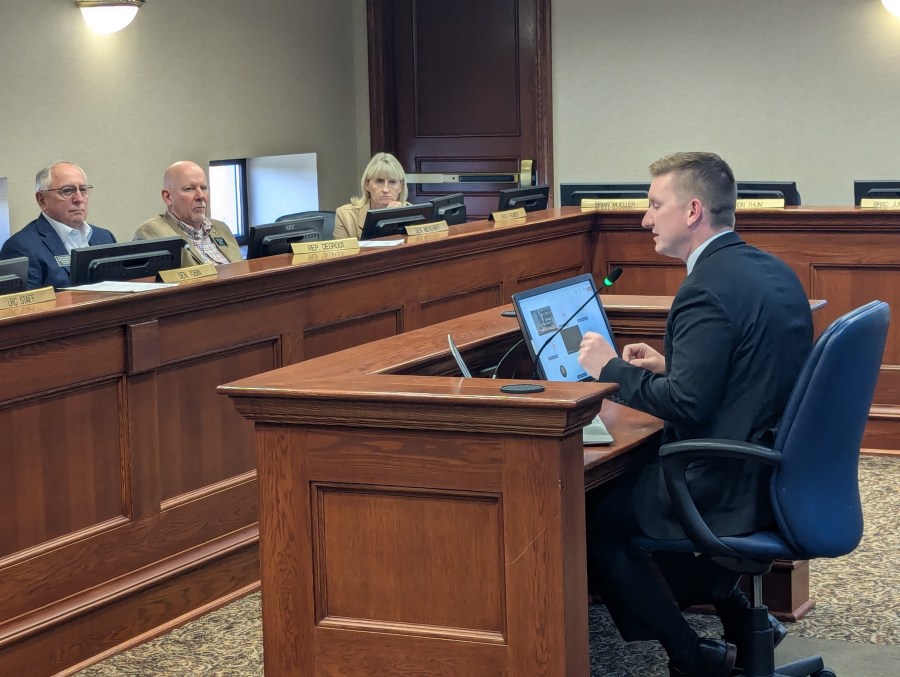PIERRE, S.D. (KELO) — A recent report from the The Ohio State University school of law will be a must-read for South Dakota legislators if voters here in the November 5 election approve Initiated Measure 29 that would legalize marijuana use by adults.
Kittrick Jeffries, a Rapid City-based owner of 1889 Farms and Puffy’s dispensaries that grow and sell medical cannabis in South Dakota, made that recommendation on Monday during a meeting of the Legislature’s Medical Marijuana Oversight Committee.
President Biden releases video with Madison mayor
Jeffries was answering a question from Republican Rep. Roger DeGroot, who wanted to know what happens to medical cannabis businesses in South Dakota if IM29 passes.
Kittrick recommended that legislators look at Ohio’s experience. Voters there approved adult-use marijuana last November. That came after Ohio legislators had legalized medical marijuana in 2016 and the first dispensary licenses were awarded in 2018.
The Ohio report suggested several policy priorities for medical marijuana in the wake of adult-use legalization. Those included:
Preserve supply of reasonably priced marijuana products for medical patients. The report recommends that “regulators and policymakers pay close attention to ensuring that there is a sufficient supply of marijuana product by monitoring growth rate in cultivation areas ofapproved licensees and considering adoption of official policies that would prioritize supplying medical patients over recreational users similarly to what has been done in the state of Illinois.”
Enhance access to medical marijuana for patients in need. The reports recommends that Ohio lawmakers “should consider allowing home delivery of medical marijuana product to registered patients, relaxing the requirement for annual registration and doctor recommendation, especially for patients with chronic conditions, and revising allowable purchase limits for medical patients to align them with the significantly higher limits under the adult-use statute.”
Ensure needed potency is available for patients. The reports recommends that Ohio lawmakers “explore further limiting the potency of marijuana products in Ohio dispensaries. In any future reforms, policymakers should make a distinction between recreational and medical users, as these two groups might have different needs in respect to marijuana potency.”
According to the IM29 official explanation by South Dakota Attorney General Marty Jackley, the ballot measure would allow people age 21 or older to possess up to two ounces of marijuana in a form other than marijuana concentrate, grow up up to six marijuana plants with no more than 12 plants per household, as well as ingest and distribute marijuana or marijuana paraphernalia.
Driving under the influence of marijuana would remain illegal if IM29 passes, according to Jackley, and employers could restrict marijuana use by their employees. He said that property owners also could regulate marijuana use on their properties if it passes.
But Jackley also noted that judicial or legislative clarification of the measure may be necessary. That’s because the proposal doesn’t address issues such as taxation or how adult-use marijuana would be grown or distributed.
One of the IM29 sponsors, Matthew Schweich of Sioux Falls, said the ballot measure was deliberately written in open-ended fashion to give the Legislature room to choose a path and to reduce the chances of the South Dakota Supreme Court finding a violation of the one-subject requirement for ballot measures.
The one-subject rule was the reason the state’s high court in 2021 overturned Amendment A that would have legalized adult-use marijuana, after voters had approved Amendment A in 2020 with 54% support.
What isn’t clear this time is whether a majority of voters will vote yes or no on IM29. While Amendment A passed four years ago, when the adult-use issue was proposed to South Dakota voters again in 2022, it received 47% support. This year the main opposition group has reported raising more than $458,000 against it since May, while the main support group has pulled in $435,746.29 over the same period.
A recent KELOLAND News opinion poll found that more voters in the sample said they would vote against IM29 than those who said they would vote for it. The survey conducted by Emerson College reported 50% said they would vote no while 45% said they would vote yes. The poll had a 3.3% possible margin of error.
Another recent poll, conducted for South Dakota News Watch, found 44% said they would vote yes, while 51% said they would vote no.
Jeffries on Monday suggested that, if voters here do approve IM29, South Dakota could follow what some other states have done. He said other states have required that a marijuana seed be designated, before it’s planted, whether it’s for medical use or adult use and tagged differently under the seed-to-sale tracking system that South Dakota already uses for medical marijuana.
Another question if IM29 passes would be how marijuana seeds could be obtained. Jeffries said the fastest way for adult-use implementation would be to grandfather the medical-marijuana use market into the adult-use market for six months to one year. That would give time for state government to “hash out” the rules and regulations, including who would regulate each license type, according to Jeffries.
The state Department of Health currently administers medical cannabis, while Amendment A would have involved the state Department of Revenue, too. Emily Kerr, administrator for the medical marijuana program, had already left the oversight panel’s meeting when DeGroot asked the question.







